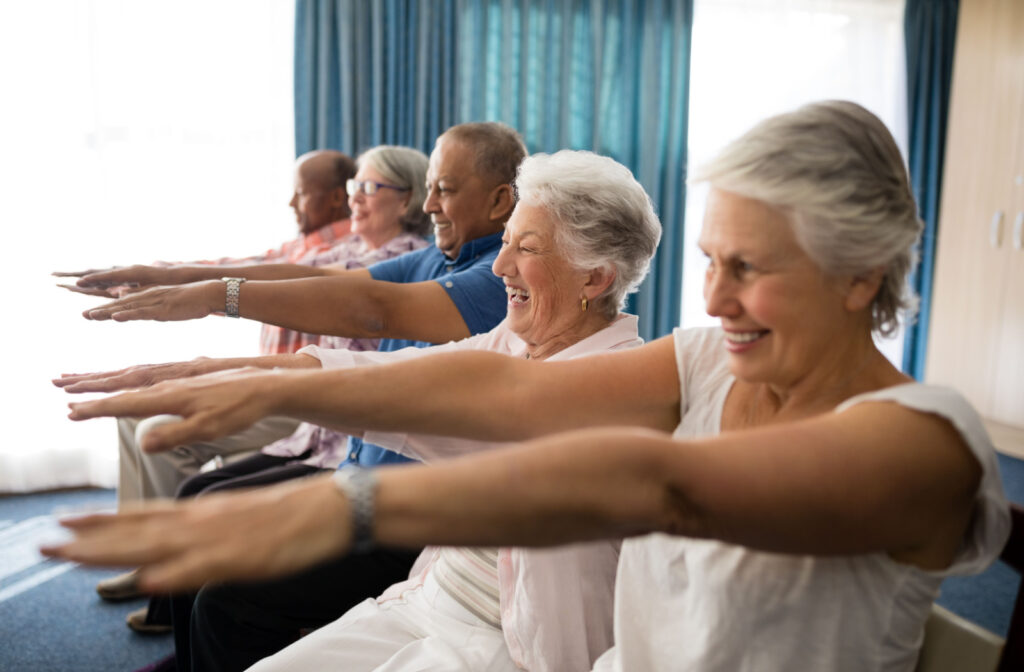As we age, looking after our physical health becomes increasingly important. Among all the aspects that older adults need to care for, such as a healthy diet, maintaining social engagement and physical activity, and managing conditions, balance might not immediately come to mind.
However, mobility and balance are crucial for maintaining an independent lifestyle for longer and preventing falls, where both can contribute significantly to overall well-being.
Why Is Balance Important for Older Adults?
Balancing your body is sometimes the silent superhero that allows older adults to go about their daily activities. Balance is vital for older adults when it comes to preserving independence and preventing potential falls.
As we age, our muscles weaken, joints become less flexible, and sensory perception diminishes. These factors can make maintaining balance a real challenge, where 25% of adults 65 and over fall and 3 million older adults receive treatment in emergency departments for fall injuries. Fall-related injuries can lead to hospitalization, immobilization, and even permanent disability.
Engaging in balance exercises helps older adults improve muscle strength, enhance joint flexibility, and sharpen their coordination to reduce the risk of falls, improve stability, boost confidence in everyday activities, and improve quality of life.
Improve Stability
Balance exercises target core muscles and improve coordination and stability. As older adults strengthen their muscles, they experience a newfound steadiness in their movements, allowing them to navigate daily activities such as walking, climbing stairs, or standing up from a seated position.
Reduce the Risk of Falls
One of the most significant advantages of balance exercises for older adults is reducing the risk of falls. By addressing muscle strength, joint flexibility, and overall balance, these exercises act as a protective shield against potential accidents.
Older adults who invest time in improving their balance are better equipped to maintain an upright posture and respond effectively to unexpected challenges, significantly lowering the likelihood of debilitating falls.
Enhance Independence
Balance exercises are not just about standing firm; they are a gateway to improved mobility. As older adults work on their balance, they can increase their range of motion, making it easier to move freely and comfortably, thus maintaining an independent lifestyle for longer.
From reaching for items on high shelves to bending down to tie shoelaces, enhanced mobility brings a sense of self-reliance and independence.
Improve Quality of Life
The cumulative effect of improved stability, reduced falls, and independence contribute to overall improvement in quality of life for older adults. These exercises go beyond the physical aspect, fostering mental and emotional well-being.
With the confidence gained from a stable foundation, older adults can actively participate in social activities, pursue hobbies, and savor the joys of daily life. The ripple effect of a balanced lifestyle is felt in every facet, creating a harmonious and fulfilling journey through the golden years.
Examples of Balance Exercises for Seniors
There are various balance exercises for older adults depending on individual abilities.
Sit-to-Stand Exercise
The sit-to-stand exercise improves balance by building leg strength. It starts with sitting on a sturdy chair with both feet on the ground. Next, shift your weight by leaning your chest over your feet and slowly rise. Once standing, sit back slowly in the chair and repeat 10 times. Older adults can improve on balance without using their hands on the chair arm to stand and sit.
Balance Exercise on One Foot
The balance exercise on one foot can help older adults with unsteady balance. Older adults can do this exercise in front of a counter or have someone nearby for safety. Begin by standing on one foot and holding for 10 seconds, working up to 30 seconds. Repeat with the other foot. Older adults can do the exercise with their eyes open or make it more challenging by closing their eyes.
How Often Should Seniors Perform Balance Exercises?
Consistency is key when it comes to reaping the benefits of balance exercises. Ideally, older adults can incorporate these exercises into their routine at least 2 to 3 times weekly. The duration can vary depending on physical limits, but this is a good starting point.
Other tips to keep in mind can include:
- Consult a healthcare provider or physical therapist before starting any exercise regime.
- Start slowly and gradually increase the difficulty level of the exercises to challenge the body.
- Take breaks often to avoid overexertion.
- Ensure you are on a healthy diet and well-hydrated.
- Warm-up and cool down before and after exercising.

A Personalized Approach to Senior Living
Balance exercises can significantly benefit older adults’s overall health and well-being. By dedicating a few moments each week to these activities, older adults can strengthen their bodies, improve stability, prevent falls, and maintain independence. But there’s a whole realm of seniors fitness programs that can offer so much.
Book a tour of The Villages of Farragut to learn about our independent living community and how we can support a loved one to live the life they always imagined with amenities and personalized services.




